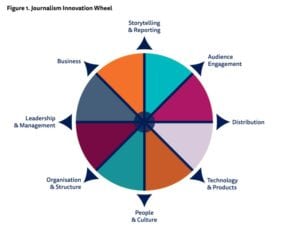
The news industry has been in a state of flux for quite some time. In an attempt to quantify and understand the change, Senior Research Fellow at the Reuters Institute of Journalism at the University of Oxford Julie Posetti recently investigated how innovation in the industry has been impacted by the relentless pace of technological and audience change. Her study, “Time to step away from the ‘bright, shiny things’? Towards a sustainable model of journalism innovation in an era of perpetual change,” raises a warning call to organizations that are focusing on constant evolution rather than identifying and committing to their own strengths, stating that “relentless, high-speed pursuit of technology-driven innovation could be almost as dangerous as stagnation.”
The report is not anti-innovation or anti-technology, but calls for “more critical reflective practice and research-informed approaches to developing integrated journalism innovation strategies that help sustain news publishing.”
For the study, Posetti examined existing research and interviewed 39 journalism experts – including international editors, CEOs, product managers, practitioners, academic experts and digital media consultants – about how digital journalism is evolving. The report identifies three key themes:
- The risks of ‘Shiny Things Syndrome’ and the impacts of ‘innovation fatigue’ in an era of perpetual change;
- Audiences: starting (again) with the end user;
- The need for a ‘user-led’ approach to researching journalism innovation and developing foundational frameworks to support it.
The report raised the need for a consensus definition of “innovation,” as it impacts journalists and the business side of news alike. The Institute has developed a “Journalism Innovation Wheel” that shows the many areas where organizations can innovate, including audience engagement, storytelling and reporting, distribution and others.

The report discusses a number of topics that keep news leaders awake at night. Publishers are unsure whether new technological developments will help them succeed and are reluctant to invest the time in answering those questions, but they also fear missing out on trends. Business pressures also impact how innovations can be assessed and their worth to companies in a changing market.
One potential solution to innovation fatigue is creating a “north star” for innovation. In the report, the needs of audiences emerged as one potential strategic focus. The report states that “innovations in audience engagement and development are more important than technological innovations (although the two are usually interrelated in digital contexts).” The audience’s needs vary greatly by publication and geography and are also related to audience polarization and trust.
Given the wide range of experiences and needs reflected in the research, collaboration and communication among news organizations is key.
